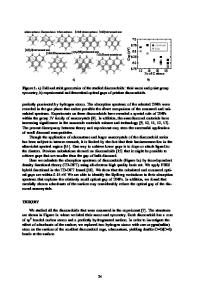Synergistic effects on band gap-narrowing in titania by doping from first-principles calculations: density functional th
- PDF / 367,585 Bytes
- 9 Pages / 432 x 648 pts Page_size
- 48 Downloads / 211 Views
Synergistic effects on band gap-narrowing in titania by doping from first-principles calculations: density functional theory studies Run Long1 and Niall J. English1 1 The SEC Strategic Research Cluster and the Centre for Synthesis and Chemical Biology, Conway Institute of Biomolecular and Biomedical Research, School of Chemical and Bioprocess Engineering, University College Dublin, Belfield, Dublin 4, Ireland ABSTRACT The large intrinsic band gap in TiO2 has hindered severely its potential application for visible-light irradiation. We have used a passivated approach to modify the band edges of anatase-TiO2 by codoping of X (N, C) with transition metals (TM=W, Re, Os) to extend the absorption edge to longer visible-light wavelengths. It was found that all the codoped systems can narrow the band gap significantly; in particular, (N+W)-codoped systems could serve as remarkably better photocatalysts with both narrowing of the band gap and relatively smaller formation energies and larger binding energies than those of (C+TM) and (N+TM)-codoped systems. Our theoretical calculations help to rationalise experimental results and provide reasonably meaningful guides for experiment to develop more powerful visible-light photocatalysts. INTRODUCTION Titania (TiO2)-based photocatalysts have received intense attention as promising photocatalytic materials [1]. However, their universal use is restricted to ultraviolent light (Ȝ < 385 nm) due to the wide band gap of titania (~3.2 eV for anatase). Further, photoexcited electron-hole pairs tend to recombine relatively easily in TiO2. It is highly desirable to extend the optical absorption of TiO2-based materials to the visible-light region with the minimum of photogenerated electron-hole recombination. In general, doping is one of the most effective approaches to extend the absorption edge to the visible-light range. For instance, N-doped TiO2 is considered to be a promising photocatalyst, and it has been investigated widely, both experimentally and theoretically [2]. However, due to strongly localized N 2p states at the top of valence band [3], the photocatalytic efficiency of Ndoped TiO2 decreases because isolated empty states trap an appreciable proportion of photoexcited electrons and reduce photo-generated current [4]. Besides N-doped TiO2, C-doped TiO2 also shows photocatalytic activity under visible-light [5].Conversely, transition metal doping can also promote photocatalytic efficiency, but this is hindered by the presence of carrier recombination centers and the formation of strongly localized d states in the band gap, which serves to reduce carrier mobility substantially [6]. Recently, Gai et al. [7] proposed using a passivated codoping approach, consisting of nonmetal and metal elements, to extend the TiO2 absorption edge into the visible light range. Because defect bands are passivated, it is highly likely that they will be less effective as carrier recombination centers [8]. Recent experiments have reported that the addition of W to N-doped TiO2 can increase photocatalyt
Data Loading...










